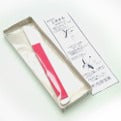It is very important to take care of a flower scissor every time you use it.
Flower Scissors are the must-have tool for ikebana. In ikebana, we say that “a flower scissor is your third hand”. If you could use your scissor like your own hands, you already are an advanced.
This column introduces you how to take care flower scissors and tools to take care of them.
The feature of flower scissors



Unlike scissors for papers, the handle of flower scissors is longer and there is no loop to put fingers. Its blades are shorter than other scissors.
In Ikenobo we use flower scissors of Warabite, which you can see on the third photo. Warabite means the edge of scissor’s handle is curving to make a little loop like bracken leaf, called warabi in Japanese. There are various size and material of flower scissors. One tip to choose your flower scissor is its size. We advise you to choose a flower scissor that a little bigger than your hand such as you can see the loop on the edge when you grab the scissor. For your guide, male hand will fit well with a scissor of about 18cm and for female is about 16cm.
How to take care of flower scissors
Stain on blades will make it difficult to move blades. After you use your scissor, you better to wipe off stain and dry it. The tools below will make it easy to take care of flower scissors.



Rub blades with Sabitoru like when you use an eraser, so you can easily remove rust from blades.


Whetstone for flower scissors which is light and small. When you use togimaru, apply water or oil lightly before sharpening blades. Please do not reciprocate whetstone when you sharpen blades. You do not need to sharpen blades every time you use it. It is enough to sharpen blades when you feel that your scissor is not sharp enough.
We advise you to keep flower scissors in flower scissor case, so it will protect your scissors from dirt.

